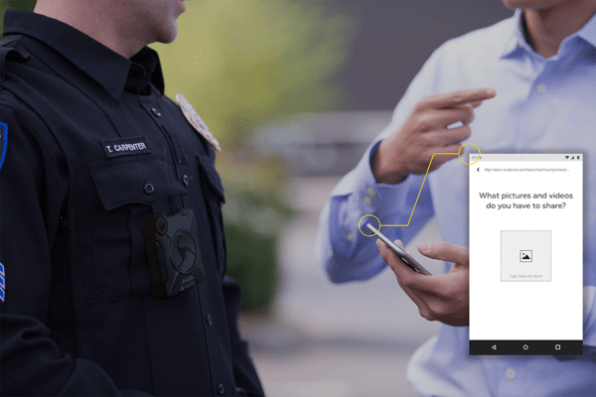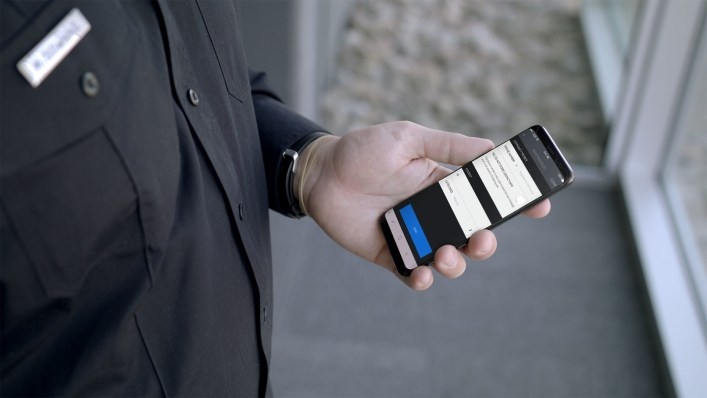To Crowdsource Crime-Fighting, A Cop Camera Giant Eyes Your Videos
Axon, the police supplier formerly known as Taser and now a leading maker of police body cameras, has also charged into police software with a service that allows police to manage and eventually analyze increasingly large caches of video, like a Dropbox for cops. Now it wants to add the public’s video to the mix.
An online tool called Citizen, set to launch later this year, will allow police to solicit the public for photos or video in the aftermath of suspected crimes and ingest them into Axon’s online data platform. Todd Basche, Axon’s executive vice president for worldwide products, said the tool was designed after the company conducted surveys of police customers and the public and found that potentially valuable evidence was not being collected. “They all pointed us to the need to collect evidence that’s out there in the community.”
Basche, a former VP of engineering at Apple, cited the mass shooting in Las Vegas, the 2013 Boston Marathon bombing, and the riots in Vancouver in 2011 as cases in which police have tried to gather crime-solving evidence from the public. In some cases, he said, citizen uploads “overwhelmed the website.” Evidence.com, Axon’s subscription-based online video storage and management platform, is designed to keep data encrypted and secured using detailed audit logs, and lets police track, tag, distribute, and redact video as needed. An added piece of software aims to help officers quickly sort through the massive influx of media that may be submitted and decide which are most useful and which aren’t, said Basche.
“If a fight breaks out at a football game or something, obviously you can see people taking videos, snapshots of things,” he said. “So both law enforcement said that there’s a need for this, because people are out there who have evidence, and then we wanted to make sure people were comfortable sharing that.” (In a survey Axon conducted of over 1,500 citizens, he said, 65% said they were okay with sharing cellphone pictures and videos with police in this way.)
The software lets police departments create a community-wide portal where those with potentially valuable evidence about a particular suspected crime can upload their video, photos, or audio securely. Alternatively, officers at the scene of a crime can personally review evidence captured by bystanders or neighbors, determine if it’s relevant, and then request that they share it. A mobile app lets officers text or email a link to a web portal for uploading. (The email feature won’t start until next year, says a company spokesperson.)
All submissions are entered directly into Evidence.com, “and are immediately logged in the audit trail instead of sitting on your camera roll or in your email,” Axon tells police customers in a brochure. The company won’t store people’s phone numbers, Basche said, and community members can choose to upload their files without providing contact information, too. (The company warns, however, that this isn’t foolproof: “There is still metadata embedded in the image being submitted,” and images and audio could also be used by police to identify the submitter.)
Basche stressed that Citizen’s community-wide portal is meant as a way to gather evidence around specific incidents, not as a general tip box. It is “not for community members to randomly submit evidence and claim a crime has taken place,” he said. “It’s not to rat out your neighbor.” (Last year, Apple’s App Store booted Vigilante, an app that asked users to report any crimes they witnessed; a new version of the app, minus that feature, emerged in March, also under the name Citizen.)
Who Watches The Watchers?
Anonymity or not, systems like Citizen still raise new privacy and policy questions, and could test the limits of already brittle police-community relations.
“While the tool is not intended to be an open-ended ‘tip box,’ has Axon designed the product to guarantee that departments can’t use it as such?” asked Harlan Yu, who has studied police video as a principal at the policy consultancy Upturn. For instance, he wondered, “are there controls that would stop the Las Vegas MPD from keeping an evidence submission link open long after a mass shooting took place?” Axon generally leaves decisions like these up to local departments.
Another concern relates to how long a department retains publicly submitted evidence. “Would it follow the retention and disposition schedules for body-worn camera footage, or would it follow some other retention guidelines? Different departments will likely answer this question differently.” A spokesperson said that Axon would provide support for both options, either by using either standard schedules for retaining footage, or by allowing the police agency to permit “citizen-specific retention schedules.”
The tool also underscores a central tension beneath the new police video push. In an era of increased scrutiny of police behavior, body cameras have often been described as a way to hold cops more accountable. In reality, the devices and connected software are sold to police as crime-fighting tools, a way to help lead to more prosecutions.
Transparency is a related concern: While cities spend millions on cameras being worn by thousands of police officers, the footage is ultimately controlled by police departments and often unseen by the public. In addition to the restrictions of individual agencies, many states have passed laws that keep body camera footage out of public records.
Would Citizen, for instance, also be useful for gathering civilian evidence of incidents of police misconduct or brutality? Basche didn’t initially mention that possibility, and the software’s documentation doesn’t describe such use cases. But, he said, “If there is an incident and an issue with an officer, there’s no reason this can’t be used as yet another mechanism to collect that [evidence] up.” When uploading, civilians can add captions for each file. “Whatever they write is immediately logged in the audit trail and can never be removed,” a spokesperson added.

Still, he acknowledged, as with police video generally, much will depend upon how Axon’s customers use the system and formulate their policies around it. “I couldn’t comment on a specific agency’s policies,” he said.
But as surveillance scholar Joshua Reeves told The Intercept last month about crowdsourced police video, that use case would probably not be typical. “As the history of body cameras will tell us, these [videos] are not going to be used primarily to crack down on police misbehavior.”
Putting Civilian Videos In Police Databases
Other policy and technology concerns have swelled around the mix of police data with newer tools, like video analytics and facial recognition. These technologies, Axon has said, promise to automatically tag and review a torrent of body camera footage and even someday rapidly generate police reports from it, reducing time-consuming paperwork. Such tools could be very useful, especially as more officers record hours of footage every day. (The LAPD, which has recently tapped Axon to be its “official AI partner,” has accumulated more than 33 years worth of video in the past year alone, according to Sergeant Daniel Gomez.)
Similar software could, with the right machine learning models, also scan through archives of footage in search of suspicious activity, or find the faces of wanted criminals in a crowd. But civil rights advocates worry that approach could turn cop cameras into street-level surveillance devices.
And once citizen video is ingested into a police database like Evidence.com, the footage could, like any other police data, be more easily mined later for other purposes, in a sort of dragnet fashion.
“That’s certainly a possibility,” Yu said.
Axon, which has assembled a group of engineers dedicated to machine learning and AI, is still developing its abilities to analyze video; at the same time, it plans to assemble a board of advisors dedicated to “AI ethics.” “We believe AI technology will change the future of policing with hands-free reporting, real-time intel in the field, and more transparent information,” said Basche.
Amid concerns about how the company itself controls video uploaded onto its platform, Basche also said that Axon does not own or watch any of the videos that police or citizens upload, which are managed by the Microsoft Azure cloud. “The entire company is concerned with security and privacy. We live and breathe this—our whole reputation rests on protecting this 14 petabytes of data.”
In part, Citizen fits into the company’s recent more public-facing rebranding: Earlier this year it changed its name from Taser as part of an effort to expand its repertoire and reputation beyond the controversial electrical weapons that still make up the bulk of the company’s business and that have become nearly ubiquitous in U.S. policing. CEO Rick Smith envisions a similar spread for body cameras: Axon has offered a year-long free trial of its devices and services to all law enforcement agencies in the U.S, and it wants its software to eventually serve as a central suite of police data tools, as well as a platform for distributing video to prosecutors and the public.
“The customer base that we serve, we certainly build products for law enforcement, but we’re really trying to do things that make the communities safer, and build that bond between law enforcement and the community,” said Basche.
The company has also gone on a hiring spree of tech veterans like Basche, a former Apple executive who, under Steve Jobs, led the team behind the iLife suite of software that contains iTunes and iMovie. Earlier this year, Axon acquired Dextro, a machine learning startup, to build its AI unit. The idea is to ramp up the company’s video and software business, and to import the slick design and engineering of Silicon Valley into the typically archaic technology of local law enforcement. Consider, said Basche, the way an iPhone can automatically synchronize with iTunes, where “you plug it in, boom, it worked.”
“It’s about taking the lessons learned from the best of all those things in the Valley and the highest technology and applying it to the market that, you know, really needs things to be as fast and as easy as we can make them,” said Basche. “We make Citizen so simple where you just do something that everybody is is used to doing: Hey send me a text.”
But that simplicity also belies potential risks. “It all depends,” Yu said, “on how agencies use the tool.”
Updated 6:15pm to clarify email feature release date, language around civilian’s contact information, civilian retention rules, and captions.
Fast Company , Read Full Story
(36)












